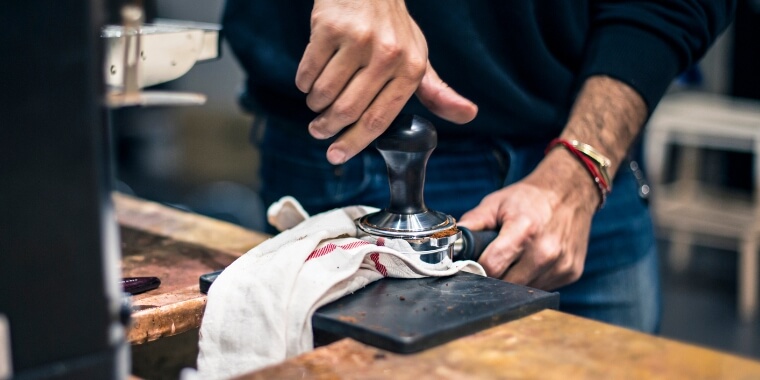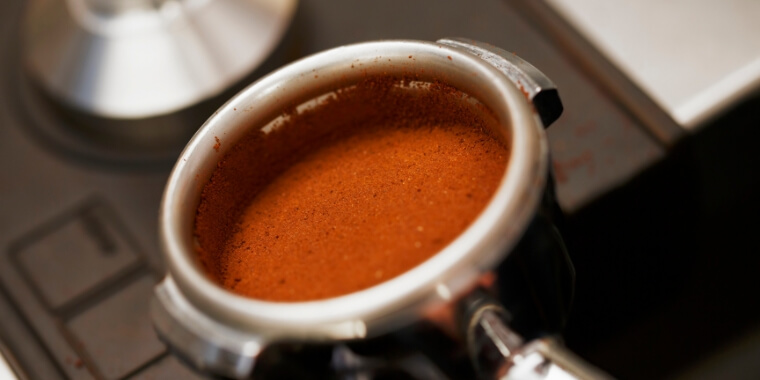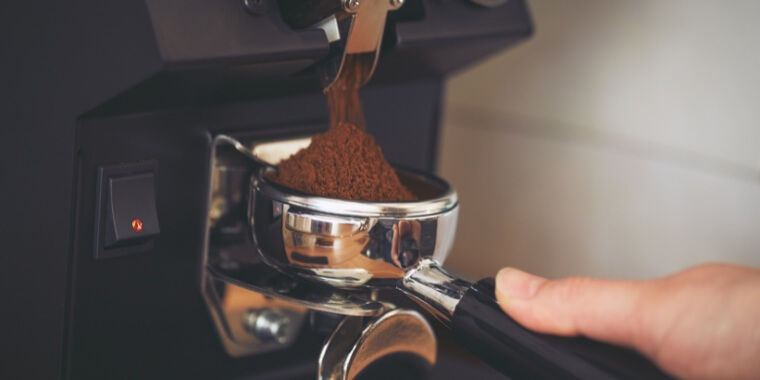If you’re wondering how to tamp espresso or how to tamper espresso effectively, you’ve come to the right place.
In this article, I’ll share my personal experience and insights on the importance of tamping in the espresso-making process.
Tamping espresso ensures the perfect extraction of flavors and guarantees a smooth and rich cup that will leave you craving more.
So, join me as we dive into the art of tamping and unlock the key to a consistently delightful espresso experience.

How to Properly Tamp Espresso: Step-by-step Guide
After trying different methods and learning from my mistakes, I’ve compiled a simple step-by-step guide to help you master the art of tamping:
Step 1: Holding and Positioning the Portafilter
A firm and steady grip on the portafilter makes a world of difference in the espresso-making process.
In my early days as an espresso enthusiast, I didn’t pay much attention to how I held the portafilter, and my espressos were inconsistent.
Once I improved my grip, I noticed a significant difference in the taste and quality of my espresso shots.
There are several techniques for holding the portafilter, and finding the one that works best for you is essential. Here are a few methods I’ve tried and found helpful:
- The Classic Grip: Hold the portafilter handle with one hand, like you would hold a tennis racket. This grip provides excellent control and stability while tamping.
- The Palm Grip: Place the portafilter handle in the palm of your hand, with your fingers wrapped around it. This grip offers increased stability and allows for more even pressure during tamping.
- The Finger Grip: Hold the portafilter handle between your thumb and index finger, with your other fingers resting on the side of the portafilter. This grip is great for those who prefer a more delicate touch while tamping.
Step 2: Holding and Positioning the Tamper
Achieving a level tamp was a bit of a challenge for me at first, but with practice and a few helpful tips, I managed to get the hang of it.
A level tamp ensures that water flows evenly through the coffee grounds, extracting all the delicious flavors and preventing channeling, which can lead to a bitter or sour espresso.
Here are some tips that helped me achieve a consistent and even tamp:
- Get into a comfortable position: I found that maintaining a stable and comfortable stance while tamping made it easier to apply even pressure. Ensure your elbow is at a 90-degree angle to maintain control.
- Use your fingertips: To help with leveling, I started using my fingertips to feel the edge of the tamper as it met the portafilter. This allowed me to better gauge the evenness of the tamp.
- Check the tamp visually: After tamping, I would take a moment to visually inspect the coffee grounds in the portafilter. If I noticed any unevenness, I would make minor adjustments to correct it.
- Practice, practice, practice: Like any skill, achieving a consistent and even tamp took time and practice. I made it a point to practice tamping whenever I had a chance, which helped me improve my technique and build muscle memory.
Step 3: Applying Even Pressure
When I first started making espresso, one of the most common questions I had was how many pounds of pressure should I use to tamp espresso.
It’s generally recommended to apply between 20-30 pounds of pressure when tamping espresso.
This range ensures that the coffee grounds are compressed just right, allowing for a smooth and even extraction.
However, gauging the right amount of pressure might not be easy, especially for beginners. Here’s how I learned to find that sweet spot:
- Get a feel for the pressure: To help me understand what 20-30 pounds of pressure felt like, I tried pushing down on filled basked on a bathroom scale with my tamper. This gave me a better idea of the force required for tamping. On the other hand, you may also invest in a click-tamper that will just apply optimal tamping pressure for you.
- Listen to your body: As weird as it sounds, I found that paying attention to my body helped me maintain consistent pressure. I would focus on keeping my arm and wrist in a straight line and applying even pressure with my fingertips.
- Watch for the tamp’s resistance: As I pressed down on the coffee grounds, I noticed that the tamper would stop moving when the maximum density was reached. This is when I would stop applying pressure, as further pressing wouldn’t make a difference.
Step 4: Polishing the Surface
After tamping, gently twist the tamper to polish the surface of the coffee grounds.
This step ensures a smooth and uniform surface, which helps create an even flow of water through the coffee during extraction.
Once you’ve polished the surface, carefully remove the tamper, and you’re ready to brew!
If you are in a hurry, here’s a brief summary:
For achieving a consistent and even tamp while making espresso, you should find the right grip, achieve a level tamp, apply even pressure, and polish the surface of the coffee grounds.
Common Tamping Mistakes and How to Avoid Them

I’ve made my fair share of mistakes while learning to tamp espresso. But it’s all part of the learning process!
To help you avoid these pitfalls, I’m sharing the most common tamping mistakes and how I managed to overcome them.
Uneven Tamping
One of the most common tamping mistakes is uneven tamping. This occurs when the tamper isn’t level, which can lead to inconsistent extraction and a less-than-perfect espresso.
To avoid this, pay close attention to the angle of the tamper when applying pressure. Make sure it’s as level as possible, and practice maintaining a steady grip throughout the process.
Applying Too Much or Too Little Pressure
Finding the right amount of pressure to apply when tamping can be a bit tricky, especially for beginners.
Applying too much pressure can result in over-extraction and a bitter taste, while too little pressure can cause under-extraction and a weak, watery espresso.
So if you are wondering how much pressure you should use to tamp espresso, aim for a consistent 30 pounds of force.
You can practice this by tamping on a bathroom scale until you get a feel for the right amount of pressure.
Remember, consistency is vital, so keep practicing until you can achieve the same pressure every time.
If you are in a hurry, here’s a brief summary:
This section highlights two common tamping mistakes: uneven tamping and applying too much or too little pressure. To avoid these errors, ensure that the tamper is level and apply a consistent 20-30 pounds of force. Consistency is crucial, so practice until you can achieve the same pressure every time.
Fine-tuning Your Tamping

Throughout my coffee journey, I’ve found that making small adjustments can have a significant impact on the end result.
Here are some tips to help you fine-tune your tamping and elevate your espresso game:
Adjusting the Grind Size
If your espresso is coming out too quickly or too slowly, it might be time to adjust the grind size of your coffee beans.
A finer grind will slow down the extraction and result in a stronger, more full-bodied espresso, while a coarser grind will speed up the extraction and yield a lighter, more delicate flavor.
Remember, finding the perfect grind size may require some trial and error, so don’t be afraid to experiment and make adjustments as needed.
Tweaking the Tamping Pressure
As I mentioned earlier, the ideal tamping pressure is around 30 pounds.
However, it’s essential to listen to your taste buds. If you find that your espresso is too bitter or too weak, try adjusting the pressure slightly.
Slight variations in pressure can have a noticeable effect on the final taste of your espresso, so don’t be afraid to experiment to find the perfect balance.
Experimenting with Different Tampers
Lastly, don’t hesitate to try different tampers.
While the classic flat tamper is a popular choice, you might find that a convex tamper works better for you.
Each tamper has its own unique characteristics and can affect the extraction process differently. By experimenting with various tampers, you’ll discover the one that best suits your tamping style and helps you achieve the perfect espresso.
If you are in a hurry, here’s a brief summary:
Tips for fine-tuning tamping while making espresso include adjusting the grind size of coffee beans, tweaking the tamping pressure, and experimenting with different types of tampers to achieve the perfect balance and elevate the espresso’s taste.
Choosing the Right Tamper

Over the years, I’ve experimented with various tampers and learned that each type has its own benefits.
In this section, I’ll help you understand the different types of tampers and guide you in choosing the perfect one for your espresso machine and personal preferences.
Types of Tampers
There are two main types of tampers: flat and convex. Both have their unique characteristics and can affect the extraction process differently. Let’s explore these two types in more detail.
Flat Tampers
Flat tampers are the most common type of tamper and, as the name suggests, have a flat base.
They provide an even and consistent pressure across the coffee grounds, resulting in a balanced extraction.
Many baristas and coffee enthusiasts prefer flat tampers because they’re easy to use and offer reliable results.
Convex Tampers
Convex tampers, on the other hand, have a slightly curved base. This shape creates a slight indentation in the coffee grounds, allowing water to flow more evenly during extraction.
Some baristas believe that convex tampers can lead to a richer, more full-bodied espresso. However, they can be a bit more challenging to master, especially for beginners.
Material and Weight
Tampers come in various materials, including stainless steel, aluminum, and brass.
Stainless steel tampers are a popular choice because they’re durable and easy to clean.
The weight of the tamper also plays a role in tamping; a heavier tamper can provide more stability and make it easier to apply consistent pressure.
Look for a tamper with a comfortable weight and a well-balanced feel in your hand.
Proper Tamper Size for Your Espresso Machine
Lastly, it’s essential to choose a tamper that fits your espresso machine’s portafilter perfectly.
Using the wrong size can lead to uneven tamping and poor extraction.
Measure the diameter of your portafilter’s basket and choose a tamper that matches this measurement as closely as possible.
Summary
If you are in a hurry, here’s a brief summary:
Finding the right tamper is an essential step in perfecting your espresso-making skills. By considering the type, material, weight, and size of the tamper, you’ll be well on your way to achieving that perfect cup of espresso every time.
Some Questions You May Have
What is tamping?
Tamping espresso is the process of compressing coffee grounds in the portafilter using a tamper. It’s an essential step in making espresso, as it ensures uniform resistance for the water to pass through the grounds, allowing for optimal extraction of flavors and a well-balanced shot.
Why do you press/tamp espresso?
You press or tamp espresso to compress the coffee grounds evenly in the portafilter. This helps create resistance for the water passing through, ensuring optimal extraction of flavors and creating a balanced, delicious espresso shot.
How tight should you pack espresso?
You should pack espresso firmly but not too tight. The goal is to create an even and consistent resistance for the water to pass through the grounds during extraction. Aim for applying 20-30 pounds of pressure when tamping to achieve the right balance. Over-packing espresso can lead to over-extraction or damage to your espresso machine, while under-packing can result in a weak and watery shot.
What happens if you tamp espresso too hard?
If you tamp espresso too hard, it can result in over-compaction of the grounds, making it difficult for water to pass through. This can lead to under-extraction, a bitter taste, and even damage to your espresso machine.
My Final Thoughts
Tamping might seem like a small step in the process, but it plays a crucial role in ensuring a balanced and delicious espresso.
Hopefully, now you know how to tamp coffee for espresso and you don’t have any further questions. If not then following the tips and techniques I’ve shared, and with a bit of patience and practice, you’ll be well on your way to espresso perfection.

